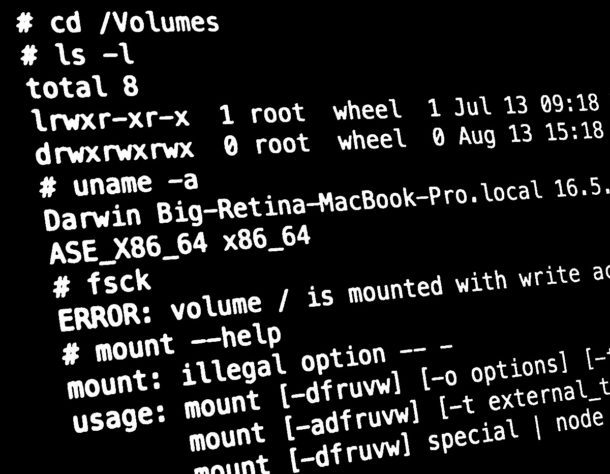How to Boot in Single User Mode on a Mac

Advanced Mac users can boot into Single User Mode, which loads directly into the command line of Mac OS and skips the familiar friendly user interface.
Booting into Single User Mode on a Mac can be helpful for some troubleshooting purposes and administrative tasks, but is generally best reserved for use by advanced Mac users with thorough knowledge of the command line.
This tutorial will show you how to boot into Single User Mode and how to exit Single User Mode on any Mac.
How to Boot Single User Mode on Mac OS
Getting into Single User Mode on a Mac can be done from system start or a system restart, you must act immediately during the boot process. Here is how to enter Single User Mode:
- Boot up the Mac or restart the computer
- As soon as the boot process begins, hold down COMMAND + S keys together
- Keep holding the Command and S keys until you see white text on a black background, indicating that single user mode is loading
- Enter the admin password to gain access to the Mac via Single User Mode
If you use FileVault disk encryption (and all Mac users should) then you will need to enter the FileVault password before being able to boot into Single User Mode.
Similarly, if you use a Mac firmware password you will need to enter that firmware password before you can load Single User Mode.
Once you’re authenticated and in Single User Mode you can run tools like fsck to repair a disk or hit the escape key twice to list all available command line commands and tools. Note that you may need to mount the file system to gain access to more familiar options.
Note that while Single User Mode gives you access to a command prompt, it is with root access and is entirely different from the regular command line interface accessed from the Terminal, with less commands, tools, programs, and other data available (without mounting the file system anyway). It’s intended to be lower level than a casual jaunt in the Terminal or using Terminal via Recovery Mode, which is why it’s useful for performing disk maintenance and repair options.
How to Exit Single User Mode on a Mac
So now you’re at the Single User Mode command line and you want to boot back into the regular Mac OS user interface. That’s easy, just initiate a command to reboot the Mac from the command line:
- From the Single User Mode command prompt, type the following syntax:
- Optionally, you can use the simpler:
- Hit return to reboot the Mac, this time don’t hold down any command sequence and Mac OS will load as usual
shutdown -r now
reboot
You can also shut down the Mac from the command line within single user mode if need be, perhaps to adjust hardware or to relocate a machine, or perform some other administrative or troubleshooting task. When you boot back up again, the Mac will boot as usual and not into Single User Mode.
If you’re interested in this, you’d likely also enjoy reading some of our other command line tips and tricks for the Mac too.


this guy is being mean
You can also exit Single User Mode and continue booting by simply typing
exit
at the shell prompt.
Won’t work on T2-protected Macs unless you disable Safe Boot, so you need to boot into Recovery Mode first, disable Safe Boot, then reboot into single user mode, then reboot into Recovery again to re-enable Safe Boot.
Also—single user mode is kinda useless if you’re on a Retina Mac: the terminal font is simply too small, so it would be nice to know if there’s a way to reduce the screen resolution in verbose and single-user mode on Retina Macs. Some nvram hack maybe?
Doesn’t work: no sigle mode screen access.
Sorry